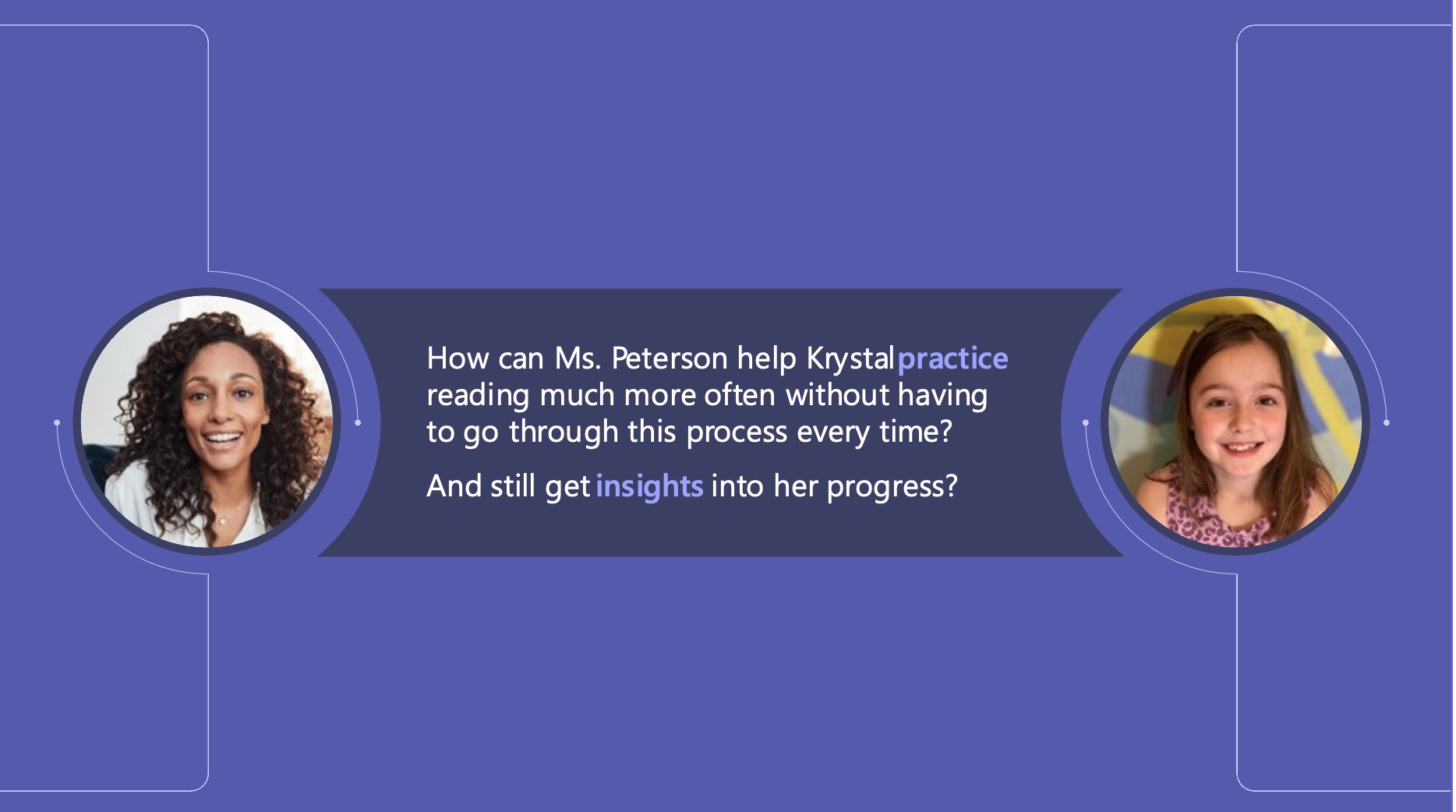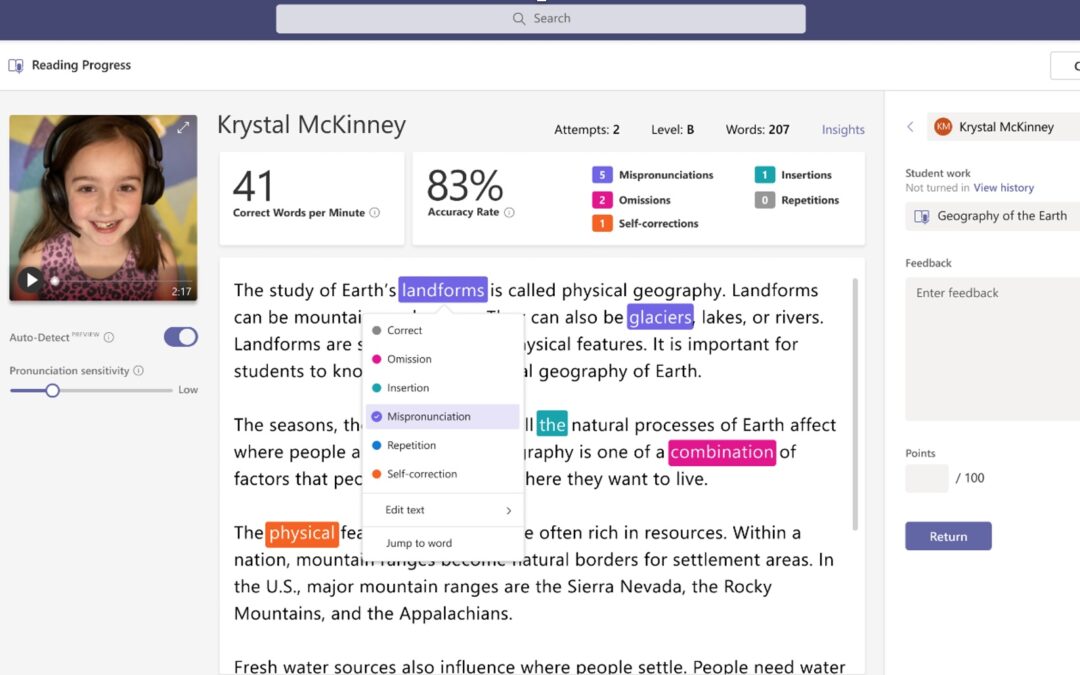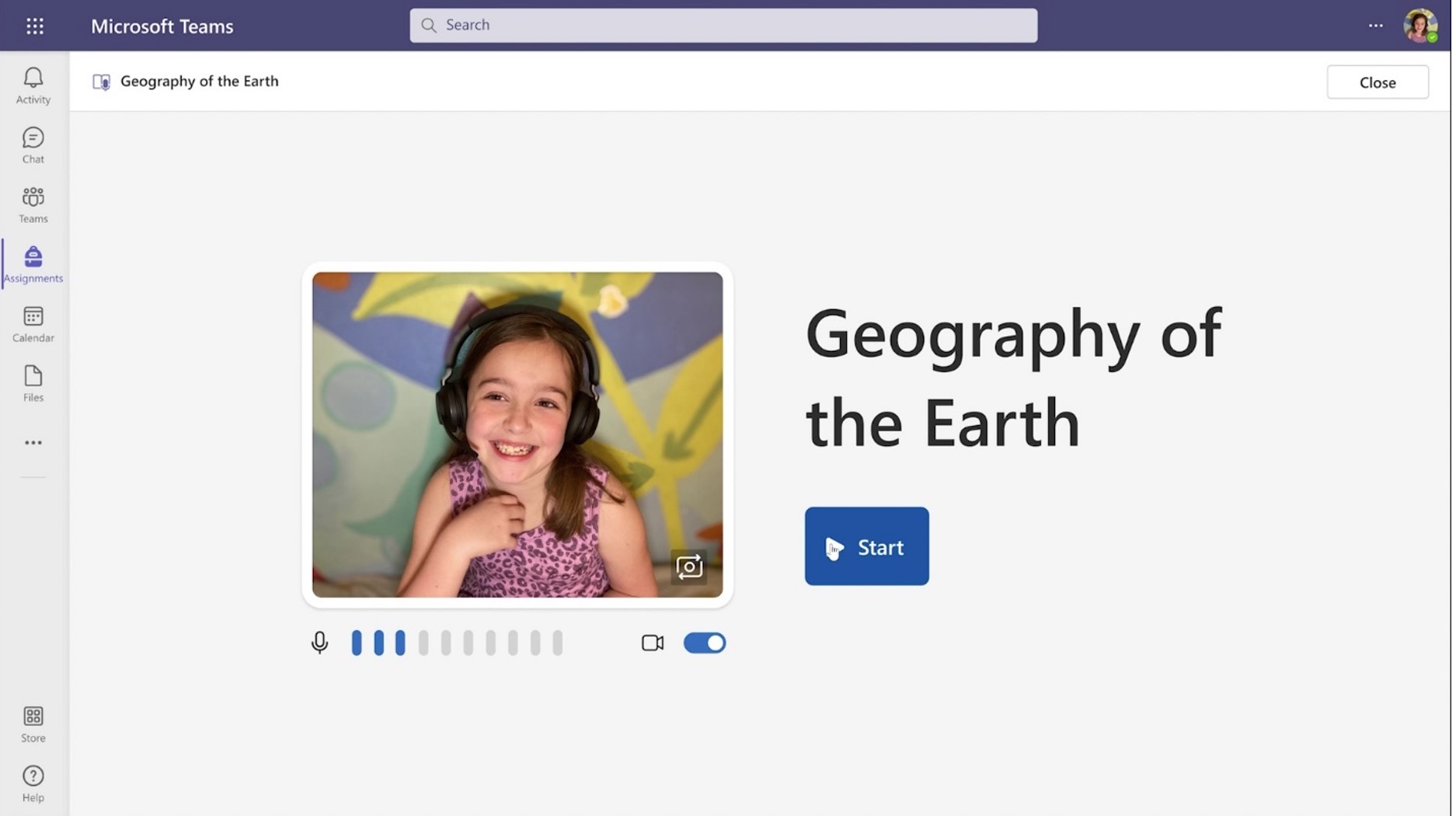I recently saw a video on an education innovation from Microsoft that had me almost literally jumping up and down in my seat with excitement. I’m not an objective observer, as Microsoft is a client, but I invite you to judge for yourselves. Here’s the full video.
Reading Progress is an app in Microsoft Teams that enables students to independently read aloud, record themselves, and grow their reading skills while allowing educators to better support students’ progression. Students share the audio or video recordings of themselves with their teachers who can then track progress, provide feedback, and discover trends and opportunities for student growth. As of March 2022 Reading Progress is available in over 90 languages.
Both students and educators benefit:
“In front of the camera, I don’t feel that stressed out. I feel like I’m less distracted, and I’m reading better – more clearly and not that slow – and I feel much more confident.” Andres, student
This is something teachers really, really needed for management, time, efficiency and effectiveness … I’ll be using this forever and always.” Jennifer Saikaly Moreno, teacher Source: https://news.microsoft.com/features/reading-progress/
A recent 2021 Stanford study showed the pandemic caused a 30% drop in reading fluency in early grades. So Microsoft’s introduction of Reading Progress could not have come at a better time.
How the Microsoft Education Team Developed and Launched Reading Progress
I interviewed one of the Microsoft Education team members, Senior Product Marketing Manager Eric Shuai, who kindly gave me some background on how Microsoft approached the development and launch of Reading Progress, and pointed me to further resources. The first thing he did was to credit the Engineering team, led by Product Manager Mike Tholfsen:
“The engineering team did an amazing job in the development of Reading Progress with deep empathy for both educators and students. They leveraged academic research, consulted with literacy experts, and solicited feedback from educators and students often, resulting in a barrage of positive feedback from our customers.” Senior Product Marketing Manager Eric Shuai
Three points stood out for me:
Senior Management supported starting with the problem.
CEO Satya Nadella encourages teams to find underserved, very important problems Microsoft technology can solve – to apply technology to a problem, not to build something just because they can.
Engineering studied the problem deeply before developing a solution.

Source: Microsoft
The Engineering team dug into the pain point, asking why, why, why, and developed deep empathy for what teachers and students are going through.
“… reading fluency is important, but it’s incredibly painful for teachers to do … they hate doing it, it takes them forever, they have to pull the kids out into a hallway where it’s loud, and the rest of the class is going crazy while they’re listening and marking (evaluations) in the hallway. The kids don’t like reading out loud, and for many it’s stigmatizing.” Product Manager Mike Tholfsen
A description of the process they followed can be found on Microsoft’s blog.
Once the team had a good handle on the problem, they leveraged their deep experience in AI technology to build a solution that solved the users’ problems, seeking out experts from all reading science methodologies and using Human Centered Design principles to iterate prototypes with teachers and students.
Marketing used storytelling to help convey the benefits.
The Marketing team got such positive, rich feedback from educators that they decided to center marketing communications on their stories (more on this below). Case studies will be an important focus.
What makes Microsoft’s Reading Progress Such a Powerful Innovation
The innovation itself:
Everett M. Rogers’ Diffusion of Innovation Theory identifies 5 qualities of a successful innovation, as seen from the users’ perspective. Microsoft appears to be tapping into several. This is my take – the real proof will come over time through user feedback on the full end-to-end experience.
| Attributions of a Successful Innovation | How Reading Progress Delivers |
| Relative advantage: the degree to which an innovation is perceived as better than the solution it replaces | Students benefit from lower performance anxiety and the ability to practice reading on their own.
Educators save time, and get much richer reading fluency data to track students’ progress |
|
Compatibility with existing values and practices: the degree to which an innovation is perceived as being consistent with the values, past experiences, and needs of potential adopters
|
The tool supports – and does not presume to substitute for – great teaching. Educators remain central to the learning experience. And they remain in control by being able to adjust app settings. |
| Simplicity and ease of use | Because Microsoft developed the app with expert advice and user input, they were able to concentrate on key features and avoided introducing unnecessary ones. They integrated Reading Progress with accessibility tools like their Immersive Reader tool to ensure learners of all abilities could use it. And Reading Progress comes embedded in Microsoft Teams Assignments many educators are already using. |
| Trialability: the degree to which an innovation can be experimented with on a limited basis | Available, free, within Microsoft Teams for Educators (still see some friction here, as not every school uses Teams) |
| Observable results | Students can see their reading fluency scores improve with practice. Educators can track the students’ progress individually and as a class. |
The decision to use story telling:
As humans we are hard wired to be receptive to stories. Stories work with all types of learners. Stories are more memorable. Storytelling forges connections between people, and between people and ideas.
Diffusion of Innovation theory also speaks to the importance of peer to peer conversations and peer networks in the successful adoption of innovations, particularly after the early adopter stage. This is because people are more likely to trust innovations that come from people like themselves.
Yes, data will be important to prove the value proposition to customers. But viewing video of students and educators allows us to vicariously feel the same joy and pride students and teachers are experiencing, which brings Reading Progress’ benefits to life more powerfully than data alone. Video is an excellent media to showcase – versus simply talk about – the full range of functional, emotional and social benefits.
Reading Coach, announced in March, is a reading practice tool for students that builds on Reading Progress and automatically generates individualized exercises based on each student’s specific needs. The following video makes full use of story telling as it showcases this new tool and shows how it works with Reading Progress.
We believe in making the customer the hero, which in this case was a teacher in Chino, CA as well as a student. We tried to show how Reading Progress and Reading Coach supports her effort to drive progress and get students excited about reading with real-time coaching and positive feedback loops. Eric Shuai
The Microsoft Education team is continuing to build on their mission to create a portfolio of literacy tools to reach every learner.
I am eager to hear what comes next, and to see the impact on this generation of readers. And I will be fascinated to see how other audiences might use this innovation – immigrants learning new languages, for example.
Questions to Consider as You Develop and Launch New Product Innovations:
- As a senior leader, how can you give your teams permission to seek out and address the most important problems?
- How can you put users at the center of your product development efforts, and continue to integrate their feedback longer term?
- What can you do to tap into all 5 qualities of a successful innovation?
- How can you use storytelling as well as data to better demonstrate the value of your innovation?
- What can you do to leverage the power of peers to accelerate adoption?
I look forward to your thoughts, as always.


 Source: Microsoft
Source: Microsoft